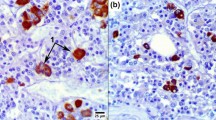Summary
Osmium tetroxide and glutaraldehyde fixation of adrenomedullary tissue presents evidence that these two fixatives preserve the tissue in quite different manners. Not only is the type of fixative of importance, but also the osmolarity of the fixatives is a prime factor in producing an accurate pictorial account of catecholamines.
Similar content being viewed by others
References
Bargmann, W., u. E. Lindner: Über den Feinbau des Nebennierenmarkes des Igels (Erinaceus europaeus L.). Z. Zellforsch. 64, 868–912 (1964).
Benedeczky, I., A. Puppi, and A. Tigyi: Histochemical and electron microscopical study of the adrenal medulla of the grass snake (Natrix natrix). Acta biol. Acad. Sci. hung. 15, 271–284 (1965).
Bennett, H. S., and J. H. Luft: S-collidine as a basis for buffering fixatives. J. biophys. biochem. Cytol. 6, 113–114 (1959).
Callas, G., and J. G. Wood: Light and electron microscopic observations on mouse adrenomedullary tissue following stress and drug administration. Anat. Rec. 151, 331 (1965).
Caulfield, J. B.: Effects of varying the vehicle for OsO4 in tissue fixation. J. biophys. biochem. Cytol. 3, 827–830 (1957).
Coupland, R. E.: Electron microscopic observations of the rat adrenal medulla. I. The ultrastructure and organization of chromaffin cells in the normal adrenal medulla. J. Anat. (Lond.) 99, 231–254 (1965).
—, A. S. Pyper, and D. Hopwood: A method for differentiating between noradrenaline and adrenaline-storing cells in the light and electron microscopes. Nature (Lond.) 201 1240–1242 (1964).
Eränkö, O., and L. Hänninen: Electron microscopic observations on the adrenal medulla of the rat. Acta path. microbiol. scand. 50, 126–132 (1960).
Hillarp, N. A.: Isolation and some biochemical properties of the catecholamine granules in the cow adrenal medulla. Acta physiol. scand. 43, 82–96 (1958).
Lever, J. D.: Electron microscopic observations on the normal and denervated adrenal medulla of the rat. Endocrinology 57, 621–635 (1955).
Millonig, G.: Advantages of a phosphate buffer for OsO4 solution in fixation. J. appl. Phys. 32, 1637 1961).
Reynolds, E. S.: The use of lead citrate at high pH as an electron-opaque stain in electron microscopy. J. Cell Biol. 17, 208–212 (1963).
Sjöstrand, F. S., u. R. Wetzstein: Elektronenmikroskopische Untersuchung der phaeochromen (chromaffinen) Granula in den Markzellen der Nebenniere. Experentia (Basel) 12, 196–199 (1955).
Torack, R. M.: The extracellular space of rat brain following perfusion fixation with glutaraldehyde and hydroxyadipaldehyde. Z. Zellforsch. 66, 352–364 (1965).
Tormey, J. McD.: Differences in membrane configuration between osmium tetroxide-fixed and glutaraldehyde-fixed ciliary epithelium. J. Cell Biol. 23, 658–664 (1964).
Tramezzani, J. H., S. Chiocchio, and G. F. Wassermann: A technique for light and electron microscopic identification of adrenalin- and noradrenalin-storing cells. J. Histochem. Cytochem. 12, 890–899 (1964).
Wassermann, G., and J. H. Tramezzani: Separate distribution of adrenaline- and noradrenaline-secreting cells in the adrenal of snakes. Gen. comp. Endocr. 3, 480–489 (1963).
Wetzstein, R.: Elektronenmikroskopische Untersuchungen am Nebennierenmark von Maus, Meerschweinchen und Katze. Z. Zellforsch. 46, 517–576 (1957).
Wood, J. G., and R. J. Barrnett: Histochemical differentiation of epinephrine and norepinephrine granules in the adrenal medulla with the electron microscope. Anat. Rec. 145, 301–302 (1963).
—: Histochemical demonstration of norepinephrine at a fine structural level. J. Histochem. Cytochem. 12, 197–209 (1964).
Yates, R. D., J. G. Wood, and D. Duncan: Phase and electron microscopic observations on two cell types in the adrenal medulla of the Syrian Hamster. Tex. Rep. Biol. Med. 20, 494–502 (1962).
Author information
Authors and Affiliations
Additional information
Supported by United States Public Health Service Grants 5-Tl-GM-459, NB 05093-02, FR 0505-01, NB 00690-11 and National Science Foundation Grant GB 25 96.— With the technical assistance of John Yates, Earl Pitsinger and Brenda Ryker.
Rights and permissions
About this article
Cite this article
Wood, J.G., Callas, G. Osmium tetroxide versus glutaraldehyde fixation in adrenomedullary tissue. Zeitschrift für Zellforschung 71, 261–270 (1966). https://doi.org/10.1007/BF00335751
Received:
Issue Date:
DOI: https://doi.org/10.1007/BF00335751




